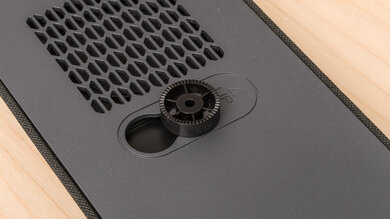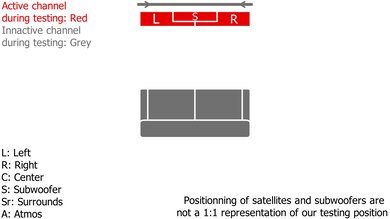The Vizio M Series M213ad-K8, also known as the M Series All-in-One (AiO) Sound Bar, is a budget-friendly 2.1 setup released in 2022. It's a standalone bar with a similar design to Vizio M Series M21d-H8R, but it adds support for Dolby Atmos. There are two subwoofers integrated into the bar to improve its bass reproduction. It's one of the only bars in this price range with Dolby Atmos support, although it has to downmix it into stereo to play it.
Our Verdict
The Vizio M Series All-in-One is decent for mixed usage. This budget-friendly 2.1 bar reproduces voices and lead instruments in your favorite songs with clarity and detail, and dialogue in TV shows is clear and present in the mix. As a standalone bar, it does struggle to reproduce an extended low-bass, which isn't surprising. You notice it most with bass-heavy music genres and action-packed movies. It supports lots of audio formats, but since it downmixes this content into stereo, it's not an impressive choice for surround sound or height content.
-
Bass and treble adjustments.
-
Dolby Atmos support.
-
Lacks low-bass.
-
Downmixes surround sound to stereo.
The Vizio M Series All-in-One is good for dialogue-focused TV shows and podcasts. It's a 2.1 bar, so you don't find a discrete center channel to improve vocal clarity. Still, you don't have any trouble following the dialogue on screen, thanks to its balanced mids that reproduce these frequencies with clarity. You can even use the 'Dialogue' EQ preset to enhance voices in the mix, which is nice. Podcasts and audiobooks are easy to stream to the bar via Bluetooth, but unfortunately, it doesn't support Wi-Fi, Apple AirPlay, or Chromecast built-in.
-
Dialogue enhancement tool.
-
Bluetooth compatibility.
-
Lacks Wi-Fi, Apple AirPlay, or Chromecast built-in support.
The Vizio M Series All-in-One is satisfactory for music. Its balanced mids mean that voices and lead instruments are clear and present, so the bar's suitable for lots of different genres. There's a little extra punch in the high bass, too, that brings some excitement to the mix. There are two subwoofers integrated into the bar to help with bass reproduction, but as with most standalone setups, it struggles to produce an extended low bass. It's most noticeable in bass-heavy genres like EDM and hip-hop, which lack rumble and thump.
-
Bass and treble adjustments.
-
Gets loud.
-
Compression at max volume.
-
Lacks low-bass.
The Vizio M Series All-in-One is okay for movies. It supports many different audio formats, from 5.1 surround sound formats like Dolby Digital to object-based formats like Dolby Atmos. You're likely to come across both on streaming services and Blu-rays. However, since it's a 2.1 bar, it has to downmix this content into stereo to play it. As a result, the sound isn't very immersive, and it doesn't seem like sound effects stretch around you. There isn't a lot of bass to bring the rumble in action-packed scenes, either.
-
Bass and treble adjustments.
-
Dolby Atmos support.
-
Lacks low-bass.
-
Downmixes surround sound to stereo.
- 7.0 Mixed Usage
- 7.5 Dialogue/TV Shows
- 7.1 Music
- 6.7 Movies
Changelog
-
Updated Jun 11, 2025:
The Height (Atmos) section was updated to correct a data error, which changed the section's score. The verdict scores also changed slightly.
- Updated Jan 29, 2024: Updated Stereo Dynamics results with new methodology. Added Audio Latency: ARC, Audio Latency: HDMI In, and Audio Latency: Optical results.
- Updated Jan 29, 2024: We've converted this review to Test Bench Update 1.3. If applicable, we've retested stereo sound based on the manufacturer's recommendations. Additionally, we've expanded our audio latency tests to the following boxes: Audio Latency: ARC, Audio Latency: HDMI In, and Audio Latency: Optical. You can see the full changelog here.
- Updated Jun 02, 2023: Converted to Test Bench 1.2. Updated the results for audio format support via ARC/eARC, HDMI In, and Optical. Added Video Passthrough to TV results as well.
- Updated Mar 20, 2023: Added cable lengths to In The Box.
Check Price
Differences Between Sizes And Variants
The Vizio M Series All-in-One is available in 'Black', and you can see the label for the model we tested here.
If you come across another version of this soundbar, let us know in the discussions, and we'll update our review.
Compared To Other Soundbars
The Vizio M Series All-in-One is a budget-friendly bar that offers Dolby Atmos support at a more affordable price, like the TCL Alto 8i. That said, since it downmixes this content, it doesn't offer a very immersive sound. It's best suited for those who prefer to listen to stereo content, like music and TV shows, but want the flexibility to enjoy surround sound and Atmos movies every once in a while.
See also our recommendations for the best standalone soundbars, the best Dolby Atmos soundbars, and the best budget soundbars.
The Vizio V Series V51-H6 is more versatile than the Vizio M Series M213ad-K8. The V Series looks pretty different than the standalone M Series—it adds a dedicated sub and two satellites to the package. It means it can reproduce a more extended low-bass and performs much better with surround sound. That said, the M Series' standalone design is ideal for those without much space. It supports Atmos content, too, unlike the V Series.
The Vizio M Series M213ad-K8 is better than the Vizio M Series M21d-H8R. They're both 2.1 budget bars with a similar standalone design, but the M213ad-K8 adds support for Dolby Atmos. Of course, it has to downmix it into stereo to play it, which isn't very immersive-sounding. Still, it adds eARC support, and it has lower latency.
The Vizio M Series M215a-J6 is a more versatile 2.1 setup than the Vizio M Series M213ad-K8. They're both Dolby Atmos soundbars, but with different designs. The standalone M213ad-K8 is better suited for those with smaller living spaces. However, the M215a-J6's dedicated subwoofer means it can reproduce a lot more bass, bringing more thump and rumble to bass-heavy music and action-packed movies.
The TCL Alto 8i and the Vizio M Series M213ad-K8 are both 2.1 soundbars with Dolby Atmos support at a budget-friendly price. The Vizio is better overall, though. It offers more sound enhancement features, like dialogue enhancement, and supports eARC and DTS content, unlike the TCL soundbar. It has lower latency, too.
The Vizio M Series M215aw-K6 is better than the Vizio M Series M213ad-K8. They're both 2.1 setups that support many different audio formats, including Dolby Atmos. However, the M213ad-K8 is a standalone bar. It's a better choice if you're low on space, but the M215aw-K6's added subwoofer makes a big difference in the sound quality, so you feel more rumble in action-packed movies and bass-heavy music genres. If you can find space for the sub, it's the better choice overall.
Test Results
The Vizio M Series All-in-One is a sleek standalone bar with a trapezoidal design that resembles the Vizio M Series M21d-H8R. It's made of plastic, and it's wrapped in tight cloth. The controls are on the side of the bar.
There's no external subwoofer; however, there are two subwoofers integrated into the bar itself.
The Vizio M Series All-in-One has a decent stereo frequency response. It's fairly balanced in the mids, so voices and lead instruments in music are clearly reproduced, and you don't have trouble hearing dialogue in your favorite TV shows. There's a little extra emphasis in the high bass to bring some punch to the mix. It's suitable for most types of stereo content, including TV shows as well as most music genres.
However, fans of bass-heavy music genres like EDM and hip-hop will be disappointed by the lack of low bass. The integrated subs are a nice touch, but they still can't bring as much rumble as setups with a dedicated subwoofer, like the Vizio M Series M215a-J6.
The Vizio M Series All-in-One has bass and treble adjustments to help you switch up its sound based on your preferences. However, if you like a more balanced sound, we recommend using its default settings.
The Vizio M Series All-in-One has a fair stereo soundstage. The soundstage is perceived to be a touch wider than the bar itself, but it doesn't have any tricks to make it seem wider than that. Its focus is just okay, so sound effects like instruments in an orchestral recording seem to come from more general areas, as opposed to each instrument seeming like it comes from a specific location that matches where the musician sits on stage.
The Vizio M Series All-In-One gets quite loud, so you don't have any issues filling a large, open space with sound. However, when you push it to max volume, there's quite a bit of compression. You'll want to listen at a more moderate level for a clear and pure audio reproduction.
The Vizio M Series All-in-One is a 2.1 bar, so it doesn't have a discrete center channel. Instead, it uses its left and right stereo channels to mimic a phantom center. Vocal clarity isn't quite as impressive as what you find with bars that have discrete centers. Still, you don't have any issues following the dialogue on screen, as the frequency response is fairly balanced in the mids where most voices reproduce.
The Vizio M Series All-in-One has to downmix 5.1 surround sound formats like Dolby Digital into stereo to play them. The resulting sound isn't very clear and real sounding, as sound effects don't seem to stretch into the space around you. Instead, it seems like audio is coming from a speaker placed in front of you.
The Vizio M Series All-in-One supports Dolby Atmos content, but its effect is somewhat limited. Atmos is designed to make it seem like sound stretches all around you, above you, and behind you. However, since it's a 2.1 bar, it has to downmix Atmos content into stereo without dedicated up-firing speakers, so you can't fully take advantage of this technology. Sound effects are clearly reproduced thanks to the relatively balanced frequency response, but you don't get the feeling that they're happening in the space around you. Instead, sound seems focused in the space in front of you. You don't notice a lot of rumble in the bass during action-packed scenes, either.
The Vizio M Series All-in-One has the same selection of sound enhancement features as the Vizio M Series M21d-H8R. It's a budget bar, so you don't have a room correction feature. As a result, it sounds a little different depending on the room you're in. That said, you can account for this a bit using its bass and treble adjustments and its presets: Movie, Music, Game, Direct, and Dialogue. Dialogue doubles as a voice enhancement feature, too.
The bar connects to your TV over Optical or HDMI. It also has an AUX VA port, which you can use to connect third-party devices to control the bar with your voice, like an Amazon Echo or Google Nest.
The Vizio M Series All-in-One supports many audio formats over ARC. You're likely to come across both Dolby Digital and Dolby Atmos content on most streaming platforms, while DTS is more common on Blu-rays.
The bar supports many audio formats over HDMI In. It supports surround sound formats like Dolby Digital as well as lossless and object-based formats like Dolby Atmos. However, it has to downmix this content into stereo to play it.
The Vizio M Series All-in-One can playback Dolby Digital and DTS over Optical. You'll find these formats on many streaming platforms and Blu-rays.
Audio latency is excellent over an ARC connection. The audio you hear is in sync with the video on screen with lots of commonly found audio formats like Dolby Digital. Some apps and TVs compensate for latency differently, though.
Audio latency also falls within good limits over a Full HDMI In connection. You don't notice lip-synching errors with common audio formats like Dolby Digital or Dolby Atmos. Some apps and TVs compensate for latency differently, though.
Audio latency is a bit higher over an Optical connection, which you may need to use if you're connecting the bar to an older TV. Especially with Dolby Digital content, you're likely to notice some lip-synching issues. Some apps and TVs compensate for this differently, though.
The Vizio M Series All-in-One can passthrough some of the highest-quality bandwidth signals, including Dolby Vision Passthrough. Text on the screen appears clear and crisp when you connect the bar between two different devices, like a TV and a PC.
The Vizio M Series All-in-One lets you wirelessly stream audio to the bar via Bluetooth.
The Vizio M Series All-in-One doesn't have a display. Instead, there are some lights on the front of the bar that illuminate and fade depending on the commands you input. You can see the manual to learn the different patterns it displays. Also, when you change the EQ mode or switch to another input, the bar provides audio feedback.
It's a simple remote that lets you control all of the bar's features. It has a similar design to other Vizio remotes; however, unlike the Vizio M Series M21d-H8R, there's no display screen included.
The Vizio M Series All-in-One doesn't have built-in voice assistant support. That said, if you own a third-party voice assistant device with Amazon Alexa or Google Assistant capabilities, you can plug it into the bar using the AUX VA port. From there, you can control the bar with your voice.
Comments
Vizio M Series M213ad-K8: Main Discussion
Let us know why you want us to review the product here, or encourage others to vote for this product.
Update: The Height (Atmos) section was updated to correct a data error, which changed the section’s score. The verdict scores also changed slightly.
- 21010
This bar would have been stellar for the price if the response wasn’t so ridiculously, grossly V shaped AND it’s missing a graphic EQ so there’s no hope of fixing it.
You guys mentioned “a little extra emphasis in the high bass”
Well…I think we have VERY different definitions of “little”, I spot at least +5, +6 dB on average over your target response between ~150Hz and 300Hz. Pair that up with putting it up against the wall and subjectively you’ll probably have a muddy, boomy mess.
Maybe I’m incorrect and subjectively this response works, but in my experience I think I would hate it.
Update: Converted to Test Bench 1.2. Updated the results for audio format support via ARC/eARC, HDMI In, and Optical. Added Video Passthrough to TV results as well.



































